Superstore Ltd Financial Accounting Homework - Year Ended June 2018
VerifiedAdded on 2023/03/17
|26
|2344
|100
Homework Assignment
AI Summary
This assignment provides a comprehensive solution to a financial accounting problem centered on Superstore Ltd's financial statements for the year ended June 30, 2018. The solution addresses several key accounting concepts, including the recognition and disclosure of liabilities, specifically focusing on warranties, bad debts, and the impact of changing tax rates. It also covers depreciation calculations, journal entries related to share capital, and the handling of impairment losses on assets. Furthermore, the assignment delves into detailed calculations for share issuance, allotment, calls, and forfeitures, alongside relevant journal entries and working notes. The solution also includes the computation of current and deferred tax, with accompanying journal entries, and analyzes revaluation and disposal of assets. Finally, the assignment encompasses the preparation of impairment loss calculations and associated accounting treatments.
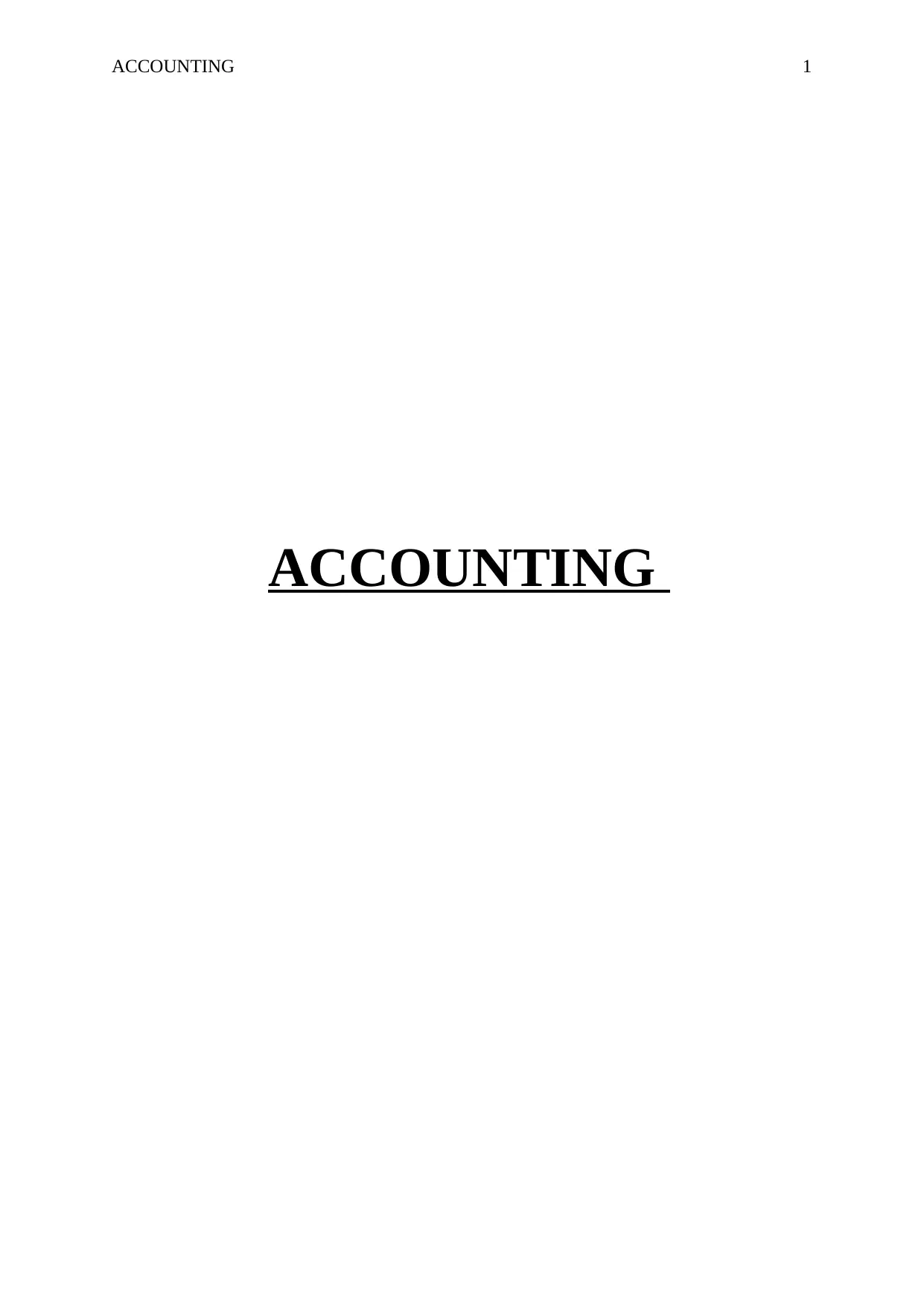
ACCOUNTING 1
ACCOUNTING
ACCOUNTING
Paraphrase This Document
Need a fresh take? Get an instant paraphrase of this document with our AI Paraphraser
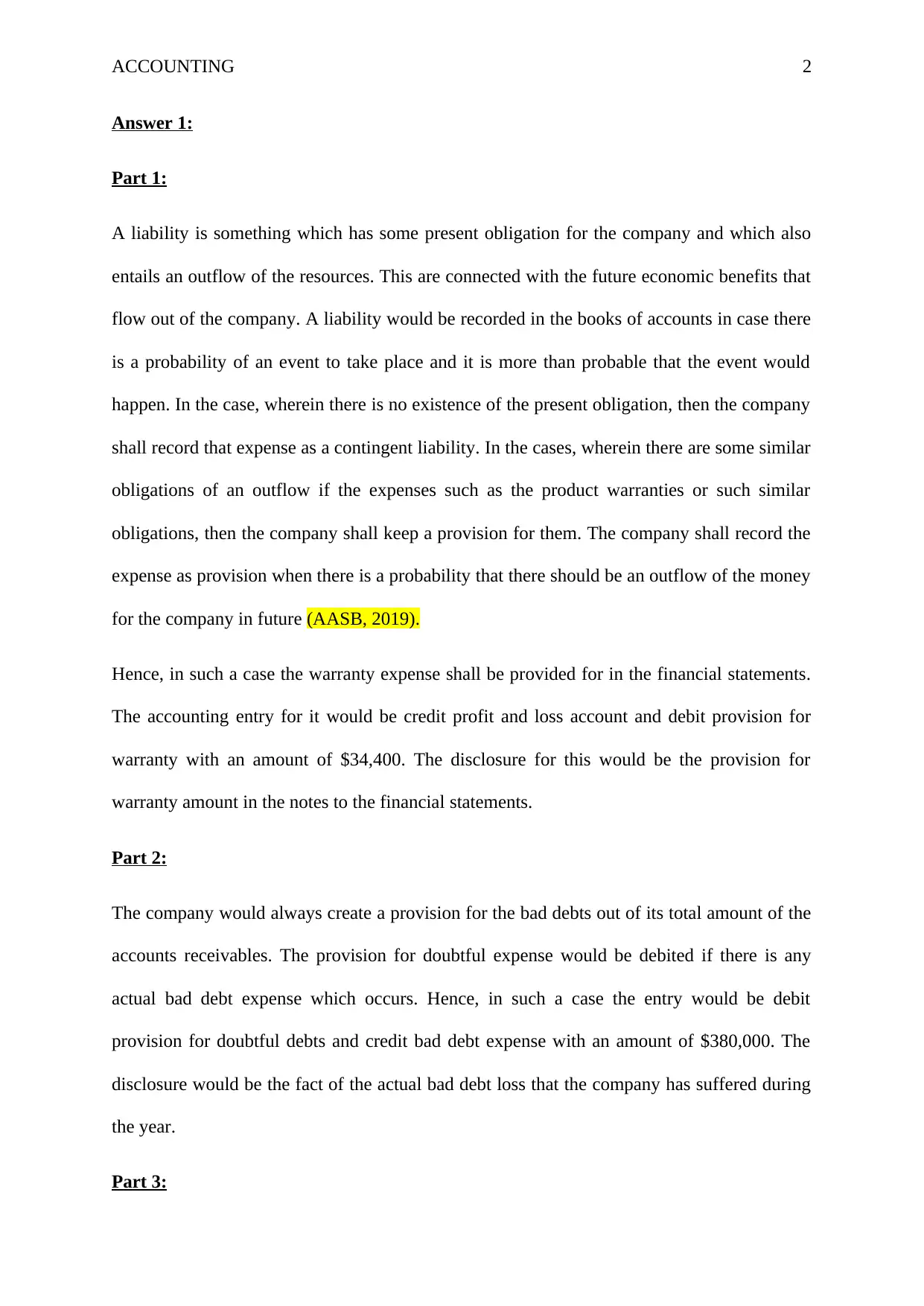
ACCOUNTING 2
Answer 1:
Part 1:
A liability is something which has some present obligation for the company and which also
entails an outflow of the resources. This are connected with the future economic benefits that
flow out of the company. A liability would be recorded in the books of accounts in case there
is a probability of an event to take place and it is more than probable that the event would
happen. In the case, wherein there is no existence of the present obligation, then the company
shall record that expense as a contingent liability. In the cases, wherein there are some similar
obligations of an outflow if the expenses such as the product warranties or such similar
obligations, then the company shall keep a provision for them. The company shall record the
expense as provision when there is a probability that there should be an outflow of the money
for the company in future (AASB, 2019).
Hence, in such a case the warranty expense shall be provided for in the financial statements.
The accounting entry for it would be credit profit and loss account and debit provision for
warranty with an amount of $34,400. The disclosure for this would be the provision for
warranty amount in the notes to the financial statements.
Part 2:
The company would always create a provision for the bad debts out of its total amount of the
accounts receivables. The provision for doubtful expense would be debited if there is any
actual bad debt expense which occurs. Hence, in such a case the entry would be debit
provision for doubtful debts and credit bad debt expense with an amount of $380,000. The
disclosure would be the fact of the actual bad debt loss that the company has suffered during
the year.
Part 3:
Answer 1:
Part 1:
A liability is something which has some present obligation for the company and which also
entails an outflow of the resources. This are connected with the future economic benefits that
flow out of the company. A liability would be recorded in the books of accounts in case there
is a probability of an event to take place and it is more than probable that the event would
happen. In the case, wherein there is no existence of the present obligation, then the company
shall record that expense as a contingent liability. In the cases, wherein there are some similar
obligations of an outflow if the expenses such as the product warranties or such similar
obligations, then the company shall keep a provision for them. The company shall record the
expense as provision when there is a probability that there should be an outflow of the money
for the company in future (AASB, 2019).
Hence, in such a case the warranty expense shall be provided for in the financial statements.
The accounting entry for it would be credit profit and loss account and debit provision for
warranty with an amount of $34,400. The disclosure for this would be the provision for
warranty amount in the notes to the financial statements.
Part 2:
The company would always create a provision for the bad debts out of its total amount of the
accounts receivables. The provision for doubtful expense would be debited if there is any
actual bad debt expense which occurs. Hence, in such a case the entry would be debit
provision for doubtful debts and credit bad debt expense with an amount of $380,000. The
disclosure would be the fact of the actual bad debt loss that the company has suffered during
the year.
Part 3:
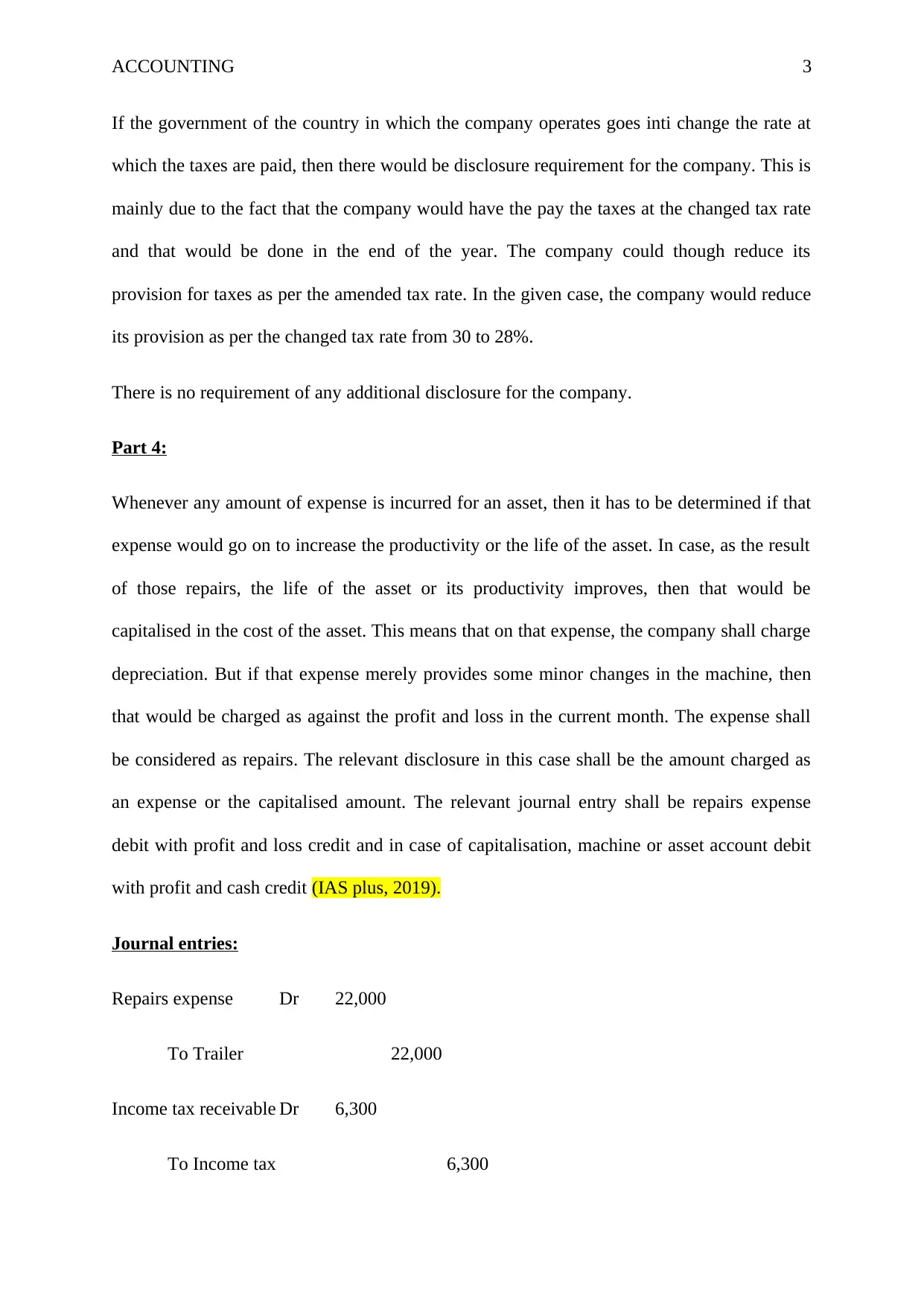
ACCOUNTING 3
If the government of the country in which the company operates goes inti change the rate at
which the taxes are paid, then there would be disclosure requirement for the company. This is
mainly due to the fact that the company would have the pay the taxes at the changed tax rate
and that would be done in the end of the year. The company could though reduce its
provision for taxes as per the amended tax rate. In the given case, the company would reduce
its provision as per the changed tax rate from 30 to 28%.
There is no requirement of any additional disclosure for the company.
Part 4:
Whenever any amount of expense is incurred for an asset, then it has to be determined if that
expense would go on to increase the productivity or the life of the asset. In case, as the result
of those repairs, the life of the asset or its productivity improves, then that would be
capitalised in the cost of the asset. This means that on that expense, the company shall charge
depreciation. But if that expense merely provides some minor changes in the machine, then
that would be charged as against the profit and loss in the current month. The expense shall
be considered as repairs. The relevant disclosure in this case shall be the amount charged as
an expense or the capitalised amount. The relevant journal entry shall be repairs expense
debit with profit and loss credit and in case of capitalisation, machine or asset account debit
with profit and cash credit (IAS plus, 2019).
Journal entries:
Repairs expense Dr 22,000
To Trailer 22,000
Income tax receivable Dr 6,300
To Income tax 6,300
If the government of the country in which the company operates goes inti change the rate at
which the taxes are paid, then there would be disclosure requirement for the company. This is
mainly due to the fact that the company would have the pay the taxes at the changed tax rate
and that would be done in the end of the year. The company could though reduce its
provision for taxes as per the amended tax rate. In the given case, the company would reduce
its provision as per the changed tax rate from 30 to 28%.
There is no requirement of any additional disclosure for the company.
Part 4:
Whenever any amount of expense is incurred for an asset, then it has to be determined if that
expense would go on to increase the productivity or the life of the asset. In case, as the result
of those repairs, the life of the asset or its productivity improves, then that would be
capitalised in the cost of the asset. This means that on that expense, the company shall charge
depreciation. But if that expense merely provides some minor changes in the machine, then
that would be charged as against the profit and loss in the current month. The expense shall
be considered as repairs. The relevant disclosure in this case shall be the amount charged as
an expense or the capitalised amount. The relevant journal entry shall be repairs expense
debit with profit and loss credit and in case of capitalisation, machine or asset account debit
with profit and cash credit (IAS plus, 2019).
Journal entries:
Repairs expense Dr 22,000
To Trailer 22,000
Income tax receivable Dr 6,300
To Income tax 6,300
⊘ This is a preview!⊘
Do you want full access?
Subscribe today to unlock all pages.

Trusted by 1+ million students worldwide
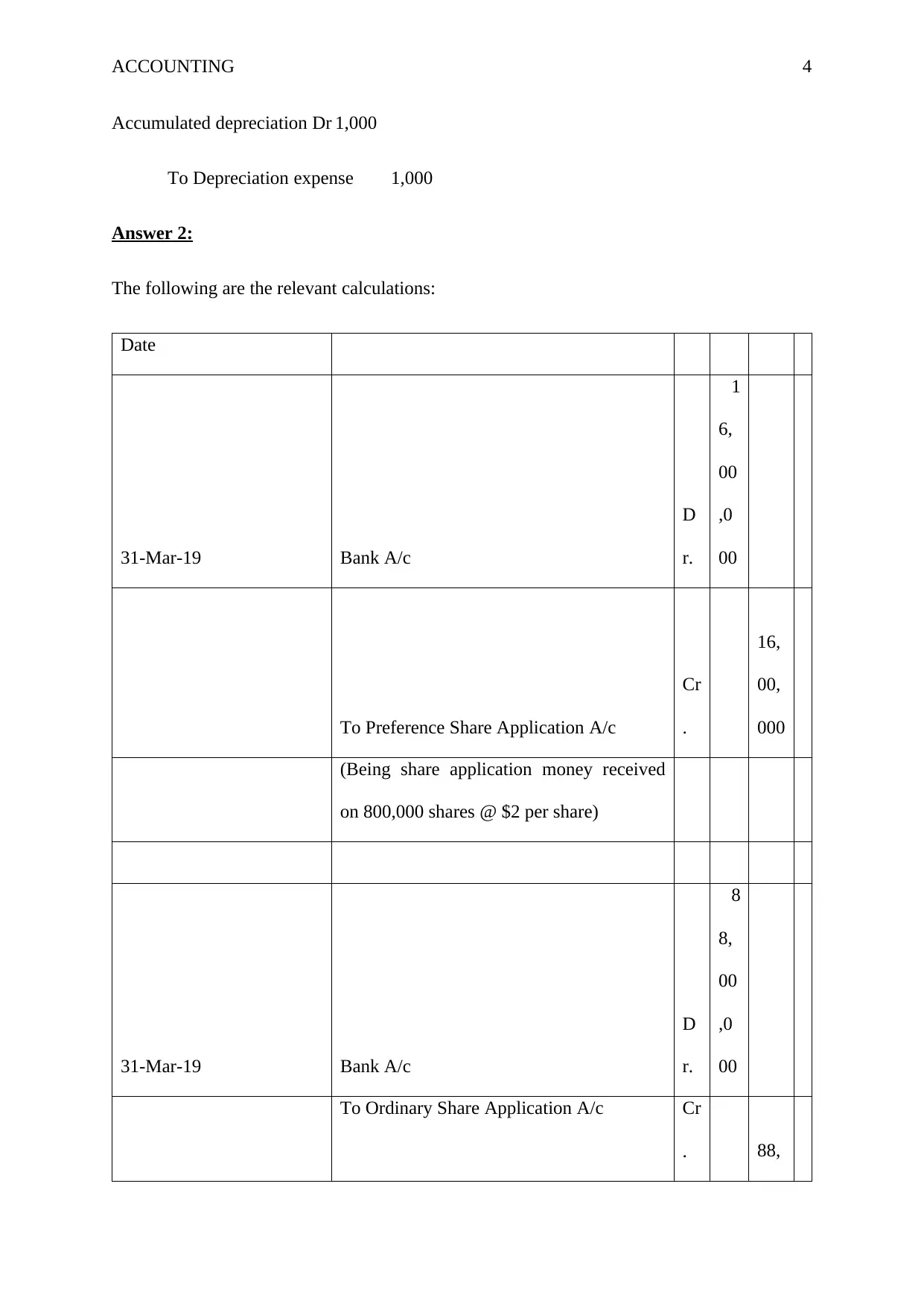
ACCOUNTING 4
Accumulated depreciation Dr 1,000
To Depreciation expense 1,000
Answer 2:
The following are the relevant calculations:
Date
31-Mar-19 Bank A/c
D
r.
1
6,
00
,0
00
To Preference Share Application A/c
Cr
.
16,
00,
000
(Being share application money received
on 800,000 shares @ $2 per share)
31-Mar-19 Bank A/c
D
r.
8
8,
00
,0
00
To Ordinary Share Application A/c Cr
. 88,
Accumulated depreciation Dr 1,000
To Depreciation expense 1,000
Answer 2:
The following are the relevant calculations:
Date
31-Mar-19 Bank A/c
D
r.
1
6,
00
,0
00
To Preference Share Application A/c
Cr
.
16,
00,
000
(Being share application money received
on 800,000 shares @ $2 per share)
31-Mar-19 Bank A/c
D
r.
8
8,
00
,0
00
To Ordinary Share Application A/c Cr
. 88,
Paraphrase This Document
Need a fresh take? Get an instant paraphrase of this document with our AI Paraphraser
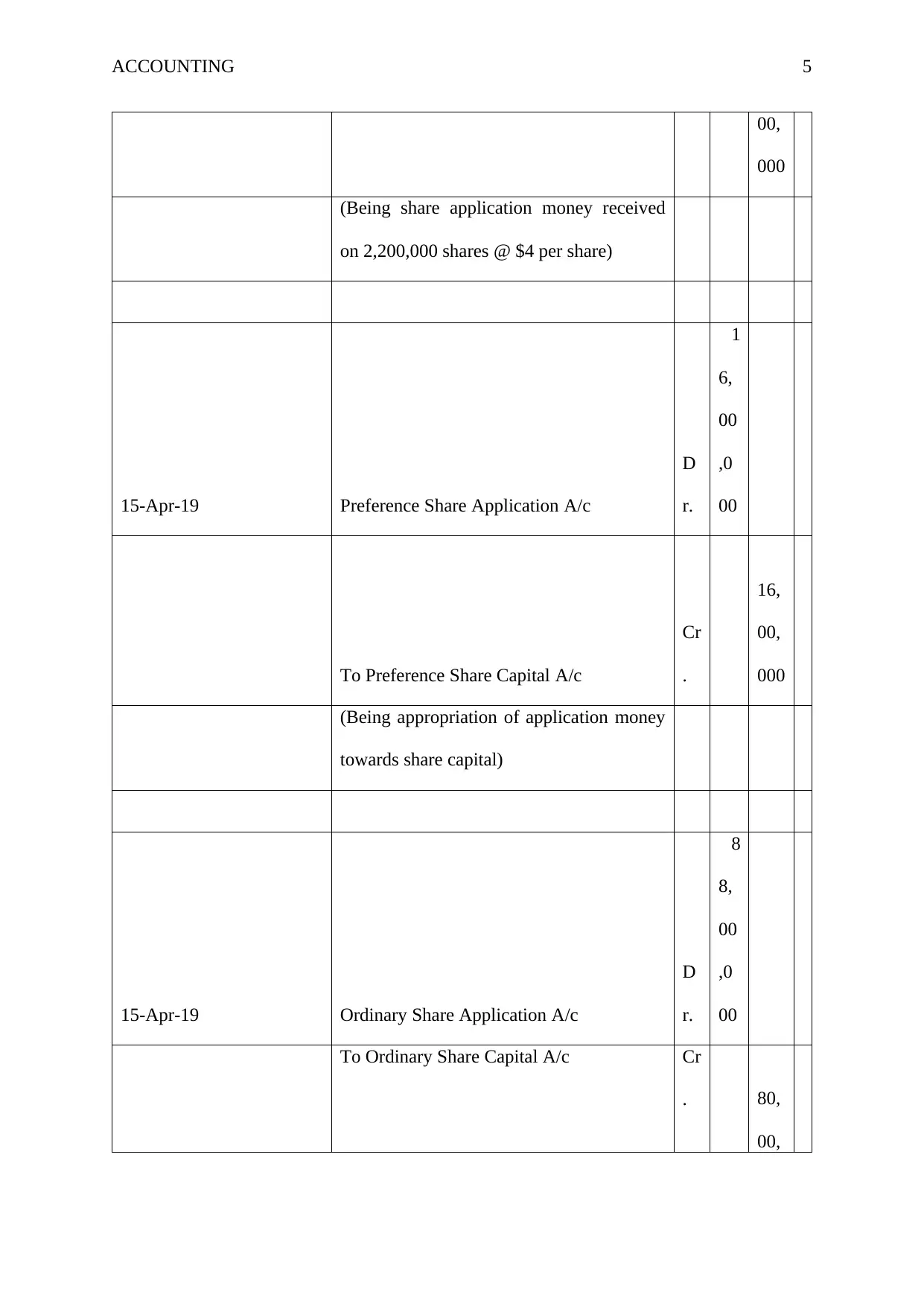
ACCOUNTING 5
00,
000
(Being share application money received
on 2,200,000 shares @ $4 per share)
15-Apr-19 Preference Share Application A/c
D
r.
1
6,
00
,0
00
To Preference Share Capital A/c
Cr
.
16,
00,
000
(Being appropriation of application money
towards share capital)
15-Apr-19 Ordinary Share Application A/c
D
r.
8
8,
00
,0
00
To Ordinary Share Capital A/c Cr
. 80,
00,
00,
000
(Being share application money received
on 2,200,000 shares @ $4 per share)
15-Apr-19 Preference Share Application A/c
D
r.
1
6,
00
,0
00
To Preference Share Capital A/c
Cr
.
16,
00,
000
(Being appropriation of application money
towards share capital)
15-Apr-19 Ordinary Share Application A/c
D
r.
8
8,
00
,0
00
To Ordinary Share Capital A/c Cr
. 80,
00,
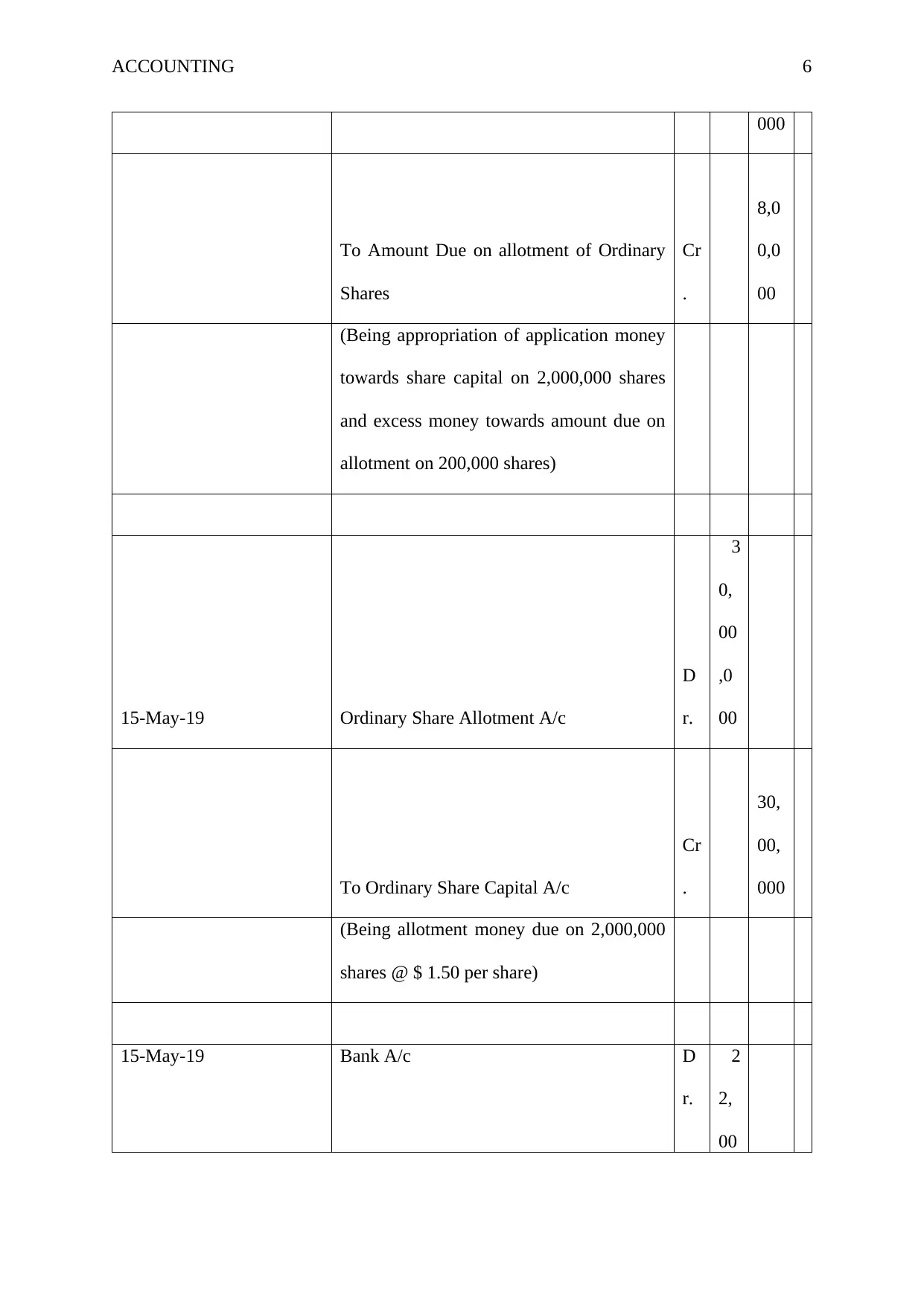
ACCOUNTING 6
000
To Amount Due on allotment of Ordinary
Shares
Cr
.
8,0
0,0
00
(Being appropriation of application money
towards share capital on 2,000,000 shares
and excess money towards amount due on
allotment on 200,000 shares)
15-May-19 Ordinary Share Allotment A/c
D
r.
3
0,
00
,0
00
To Ordinary Share Capital A/c
Cr
.
30,
00,
000
(Being allotment money due on 2,000,000
shares @ $ 1.50 per share)
15-May-19 Bank A/c D
r.
2
2,
00
000
To Amount Due on allotment of Ordinary
Shares
Cr
.
8,0
0,0
00
(Being appropriation of application money
towards share capital on 2,000,000 shares
and excess money towards amount due on
allotment on 200,000 shares)
15-May-19 Ordinary Share Allotment A/c
D
r.
3
0,
00
,0
00
To Ordinary Share Capital A/c
Cr
.
30,
00,
000
(Being allotment money due on 2,000,000
shares @ $ 1.50 per share)
15-May-19 Bank A/c D
r.
2
2,
00
⊘ This is a preview!⊘
Do you want full access?
Subscribe today to unlock all pages.

Trusted by 1+ million students worldwide
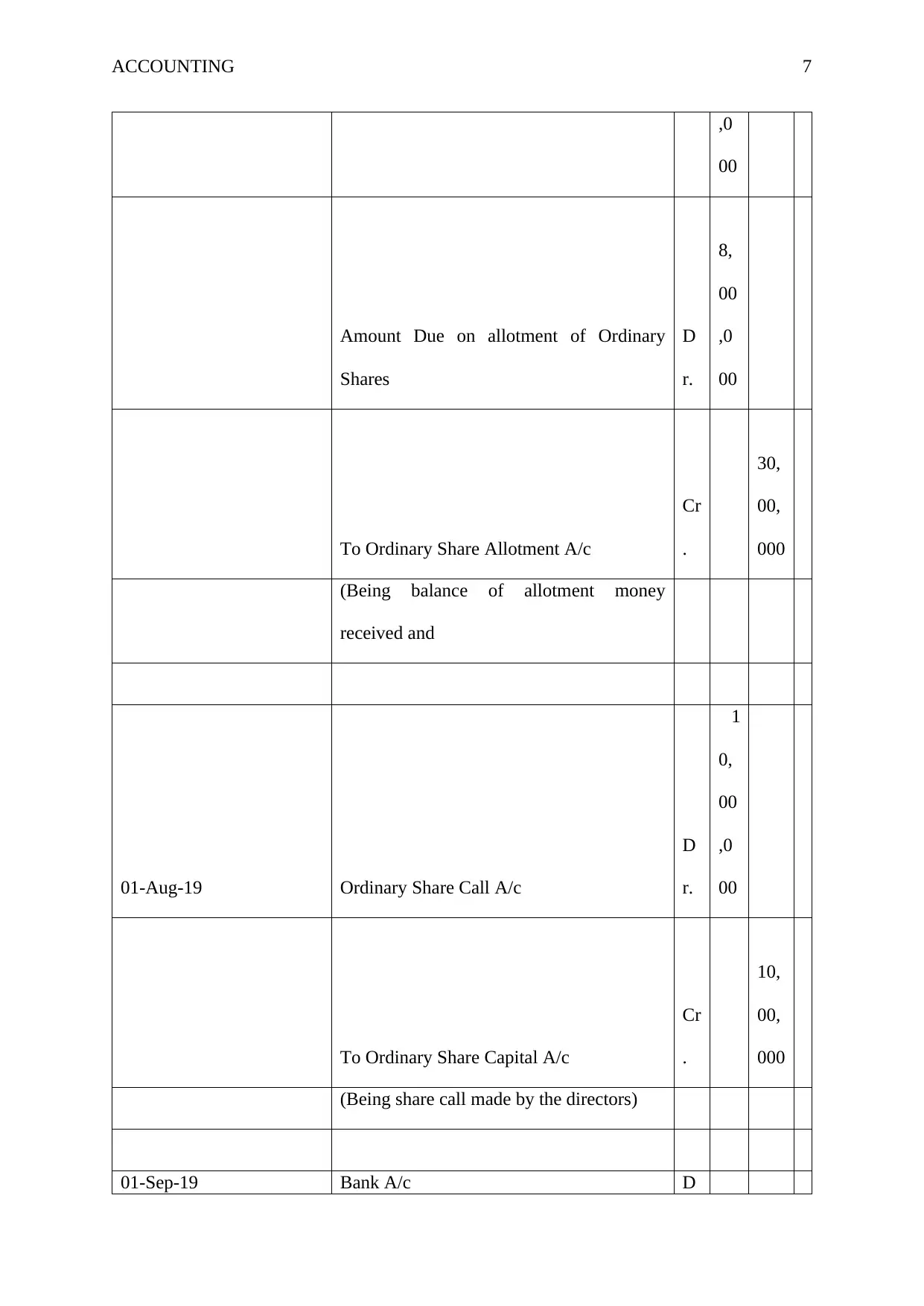
ACCOUNTING 7
,0
00
Amount Due on allotment of Ordinary
Shares
D
r.
8,
00
,0
00
To Ordinary Share Allotment A/c
Cr
.
30,
00,
000
(Being balance of allotment money
received and
01-Aug-19 Ordinary Share Call A/c
D
r.
1
0,
00
,0
00
To Ordinary Share Capital A/c
Cr
.
10,
00,
000
(Being share call made by the directors)
01-Sep-19 Bank A/c D
,0
00
Amount Due on allotment of Ordinary
Shares
D
r.
8,
00
,0
00
To Ordinary Share Allotment A/c
Cr
.
30,
00,
000
(Being balance of allotment money
received and
01-Aug-19 Ordinary Share Call A/c
D
r.
1
0,
00
,0
00
To Ordinary Share Capital A/c
Cr
.
10,
00,
000
(Being share call made by the directors)
01-Sep-19 Bank A/c D
Paraphrase This Document
Need a fresh take? Get an instant paraphrase of this document with our AI Paraphraser
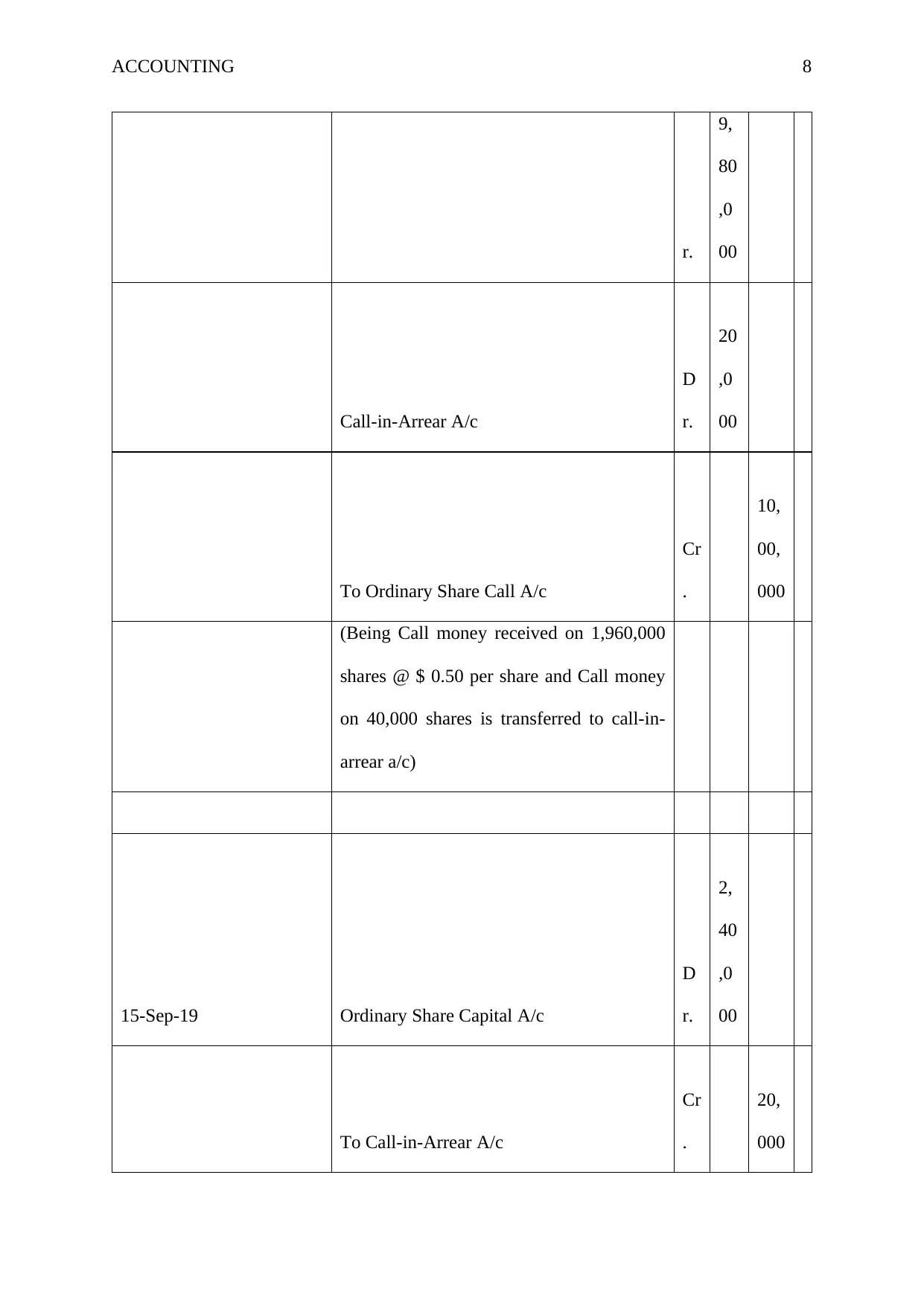
ACCOUNTING 8
r.
9,
80
,0
00
Call-in-Arrear A/c
D
r.
20
,0
00
To Ordinary Share Call A/c
Cr
.
10,
00,
000
(Being Call money received on 1,960,000
shares @ $ 0.50 per share and Call money
on 40,000 shares is transferred to call-in-
arrear a/c)
15-Sep-19 Ordinary Share Capital A/c
D
r.
2,
40
,0
00
To Call-in-Arrear A/c
Cr
.
20,
000
r.
9,
80
,0
00
Call-in-Arrear A/c
D
r.
20
,0
00
To Ordinary Share Call A/c
Cr
.
10,
00,
000
(Being Call money received on 1,960,000
shares @ $ 0.50 per share and Call money
on 40,000 shares is transferred to call-in-
arrear a/c)
15-Sep-19 Ordinary Share Capital A/c
D
r.
2,
40
,0
00
To Call-in-Arrear A/c
Cr
.
20,
000
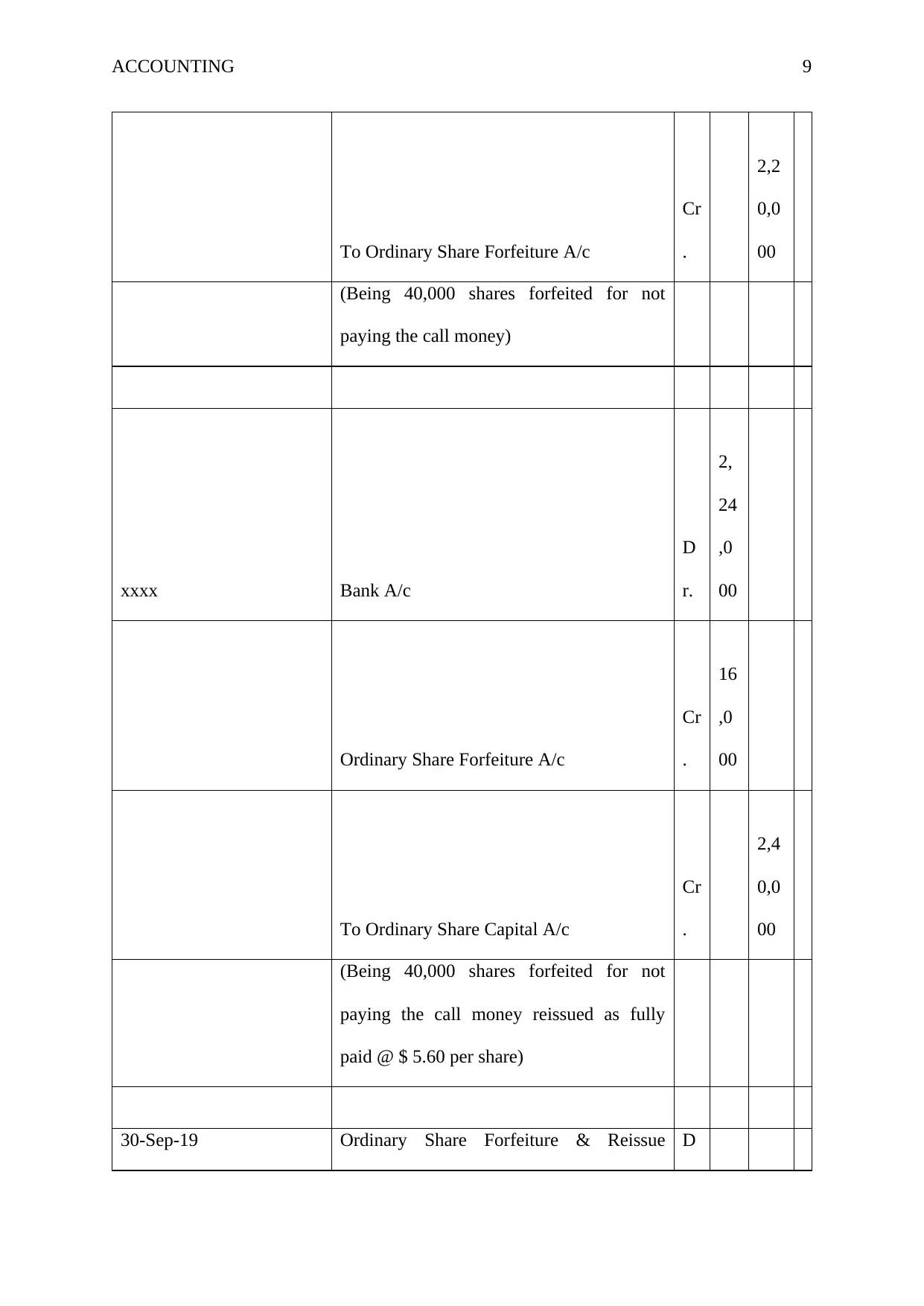
ACCOUNTING 9
To Ordinary Share Forfeiture A/c
Cr
.
2,2
0,0
00
(Being 40,000 shares forfeited for not
paying the call money)
xxxx Bank A/c
D
r.
2,
24
,0
00
Ordinary Share Forfeiture A/c
Cr
.
16
,0
00
To Ordinary Share Capital A/c
Cr
.
2,4
0,0
00
(Being 40,000 shares forfeited for not
paying the call money reissued as fully
paid @ $ 5.60 per share)
30-Sep-19 Ordinary Share Forfeiture & Reissue D
To Ordinary Share Forfeiture A/c
Cr
.
2,2
0,0
00
(Being 40,000 shares forfeited for not
paying the call money)
xxxx Bank A/c
D
r.
2,
24
,0
00
Ordinary Share Forfeiture A/c
Cr
.
16
,0
00
To Ordinary Share Capital A/c
Cr
.
2,4
0,0
00
(Being 40,000 shares forfeited for not
paying the call money reissued as fully
paid @ $ 5.60 per share)
30-Sep-19 Ordinary Share Forfeiture & Reissue D
⊘ This is a preview!⊘
Do you want full access?
Subscribe today to unlock all pages.

Trusted by 1+ million students worldwide
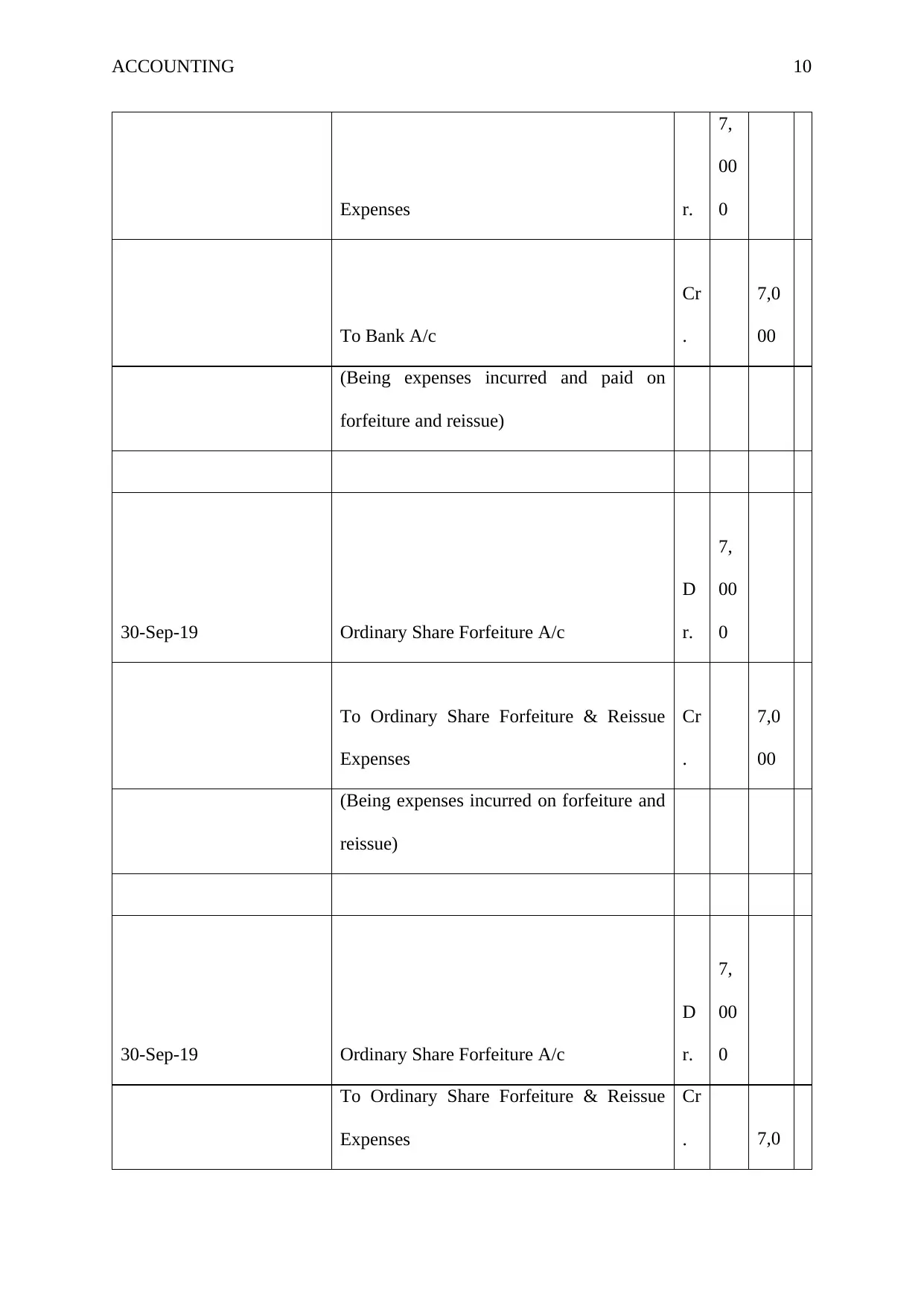
ACCOUNTING 10
Expenses r.
7,
00
0
To Bank A/c
Cr
.
7,0
00
(Being expenses incurred and paid on
forfeiture and reissue)
30-Sep-19 Ordinary Share Forfeiture A/c
D
r.
7,
00
0
To Ordinary Share Forfeiture & Reissue
Expenses
Cr
.
7,0
00
(Being expenses incurred on forfeiture and
reissue)
30-Sep-19 Ordinary Share Forfeiture A/c
D
r.
7,
00
0
To Ordinary Share Forfeiture & Reissue
Expenses
Cr
. 7,0
Expenses r.
7,
00
0
To Bank A/c
Cr
.
7,0
00
(Being expenses incurred and paid on
forfeiture and reissue)
30-Sep-19 Ordinary Share Forfeiture A/c
D
r.
7,
00
0
To Ordinary Share Forfeiture & Reissue
Expenses
Cr
.
7,0
00
(Being expenses incurred on forfeiture and
reissue)
30-Sep-19 Ordinary Share Forfeiture A/c
D
r.
7,
00
0
To Ordinary Share Forfeiture & Reissue
Expenses
Cr
. 7,0
Paraphrase This Document
Need a fresh take? Get an instant paraphrase of this document with our AI Paraphraser
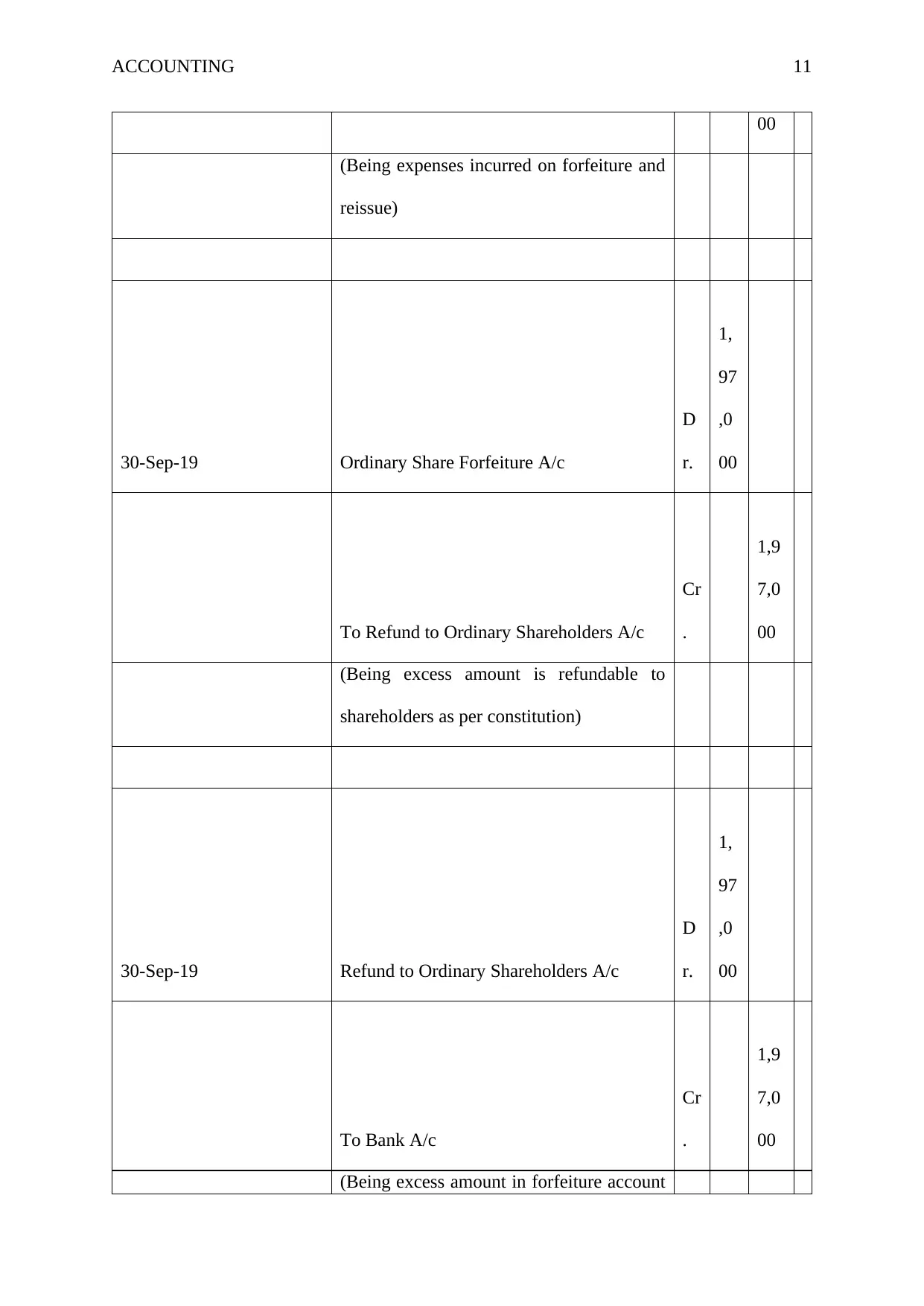
ACCOUNTING 11
00
(Being expenses incurred on forfeiture and
reissue)
30-Sep-19 Ordinary Share Forfeiture A/c
D
r.
1,
97
,0
00
To Refund to Ordinary Shareholders A/c
Cr
.
1,9
7,0
00
(Being excess amount is refundable to
shareholders as per constitution)
30-Sep-19 Refund to Ordinary Shareholders A/c
D
r.
1,
97
,0
00
To Bank A/c
Cr
.
1,9
7,0
00
(Being excess amount in forfeiture account
00
(Being expenses incurred on forfeiture and
reissue)
30-Sep-19 Ordinary Share Forfeiture A/c
D
r.
1,
97
,0
00
To Refund to Ordinary Shareholders A/c
Cr
.
1,9
7,0
00
(Being excess amount is refundable to
shareholders as per constitution)
30-Sep-19 Refund to Ordinary Shareholders A/c
D
r.
1,
97
,0
00
To Bank A/c
Cr
.
1,9
7,0
00
(Being excess amount in forfeiture account
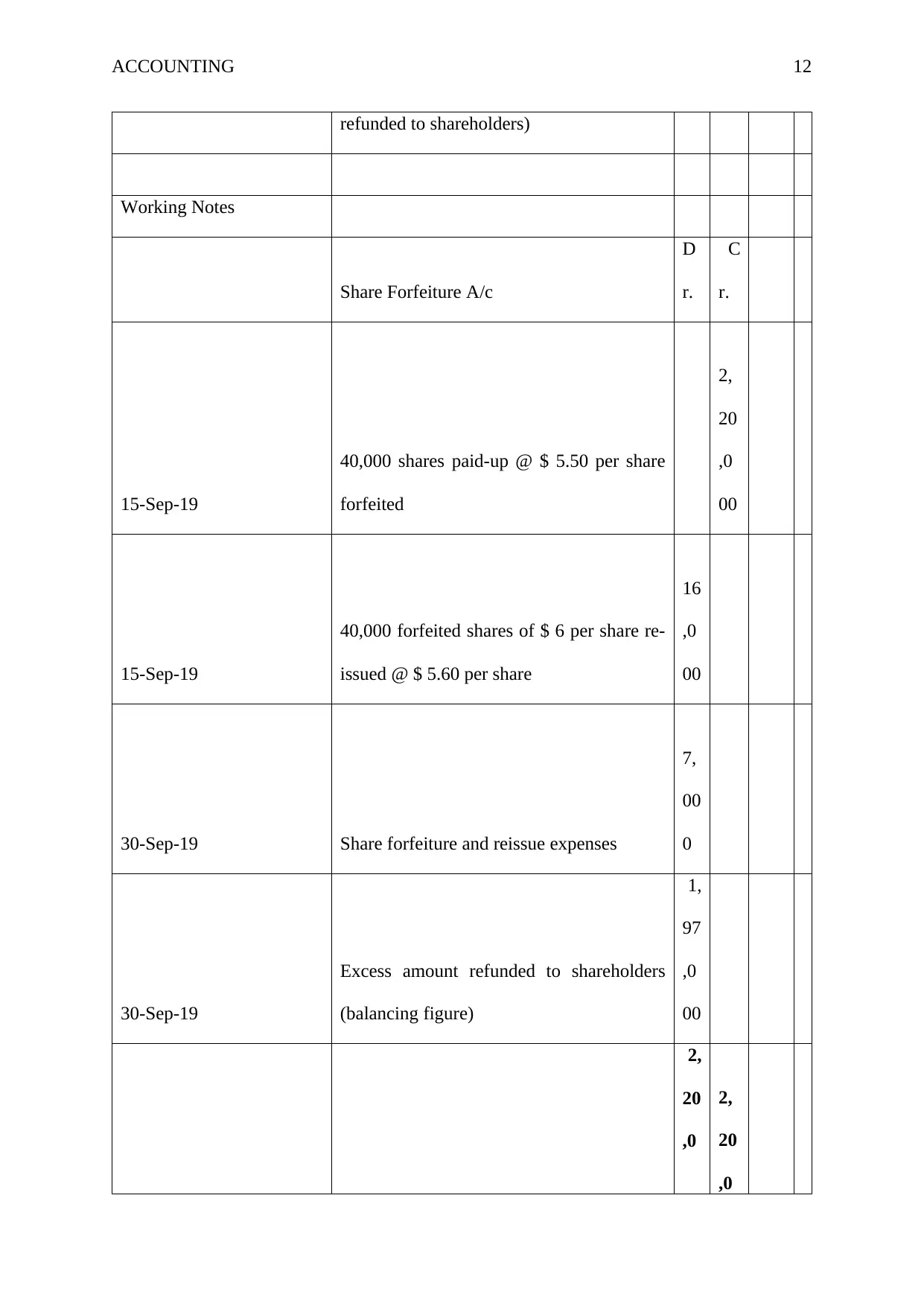
ACCOUNTING 12
refunded to shareholders)
Working Notes
Share Forfeiture A/c
D
r.
C
r.
15-Sep-19
40,000 shares paid-up @ $ 5.50 per share
forfeited
2,
20
,0
00
15-Sep-19
40,000 forfeited shares of $ 6 per share re-
issued @ $ 5.60 per share
16
,0
00
30-Sep-19 Share forfeiture and reissue expenses
7,
00
0
30-Sep-19
Excess amount refunded to shareholders
(balancing figure)
1,
97
,0
00
2,
20
,0
2,
20
,0
refunded to shareholders)
Working Notes
Share Forfeiture A/c
D
r.
C
r.
15-Sep-19
40,000 shares paid-up @ $ 5.50 per share
forfeited
2,
20
,0
00
15-Sep-19
40,000 forfeited shares of $ 6 per share re-
issued @ $ 5.60 per share
16
,0
00
30-Sep-19 Share forfeiture and reissue expenses
7,
00
0
30-Sep-19
Excess amount refunded to shareholders
(balancing figure)
1,
97
,0
00
2,
20
,0
2,
20
,0
⊘ This is a preview!⊘
Do you want full access?
Subscribe today to unlock all pages.

Trusted by 1+ million students worldwide
1 out of 26
Related Documents
Your All-in-One AI-Powered Toolkit for Academic Success.
+13062052269
info@desklib.com
Available 24*7 on WhatsApp / Email
![[object Object]](/_next/static/media/star-bottom.7253800d.svg)
Unlock your academic potential
Copyright © 2020–2025 A2Z Services. All Rights Reserved. Developed and managed by ZUCOL.





